Growing relation between art and technology
- CAMI Info
- Sep 9, 2022
- 3 min read
What would have happened to the impressionists if portable paint tubes had not been invented, allowing them to paint outside? Without silk screen printing, who would have heard of Andy Warhol? For a long time, technology has provided artists with new ways to express themselves.
Still, art and technology have become more intertwined than ever before in the last few decades, whether it's through new ways to mix different types of media, allowing more human interaction, or simply making the process of creating it easier.

Lasers –
Lasers are being used in a number of artworks now-a-days. "Assemblance," one of the most popular exhibits at the London show, encourages visitors to create light structures and floor drawings by moving through coloured laser beams and smoke. The majority of people prefer to work alone, but the shapes they create are more fragile. If a person nearby bumps into their structure, for example, it will most likely crumble. However, those who collaborate with others—even if it's just by holding hands—discover that the light structures they create are more resilient and sophisticated.
Rugs –
Another popular attraction at "Digital Revolution" is the "Petting Zoo." You get to snuggle up to snake-like tubes hanging from the ceiling instead of rubbing cute goats and furry rabbits. Doesn't that sound like a good time? But wait, these are highly responsive tubes that bend, move, and change colour in response to your movements, sounds, and touch. If they sense a large group approaching, they may withdraw shyly or become all cuddly if you're being affectionate. The immersive artwork, created by Minimaforms, is meant to give viewers a glimpse into the future when robots or even artificial pets will be able to read our emotions and respond accordingly.
Fractal Art –
Fractal Art is a type of digital art that includes mathematics. Algorithmic art refers to the process of creating art using mathematics. The culmination of this art form, which is considered a part of computer art and digital art, and is a part of the larger family of new media art, involves a specific type of beauty.
Although it is a metaphor for the introduction of modernity into the presentation of art, new media art is derived from pure art forms created during the ancient periods. With the advent of technology, the factor of modernity transformed it into digital art.
Datamoshing –
When a media file is decoded, datamoshing is a process that allows the file to be manipulated to produce the desired visual effects or images. The decoded file's status allows for the addition of snippets from other media files as well as the editing of existing ones. Rather than images, this data-mashing process is most common in videos.
This is because decoded video files allow for more manipulation than images with limited storage space. Modern video files use a complicated algorithm to avoid crossing the storage space limit. This is accomplished by only downloading snippets of the image rather than the entire image to the device.
Dynamic Paintings –
Dynamic painting is the most advanced and cutting-edge form of digital art. Historically, art was thought to have been created by man's hands, and it was assumed that art would remain in that realm.
Modernity and the Industrial Revolution, on the other hand, gave birth to technology and the adoption of new methods for transforming physical labour into mental labour, where manual labourers' jobs were demolished and replaced by the use of specialised skills to operate capitalist giants' machines. Dynamic painting is a type of digital art in which the art or picture is created by an autonomous system, such as a computer, with very little physical labour involved in the process.
Thanks for reading and don't forget to share it with someone who will enjoy this read!




Comments